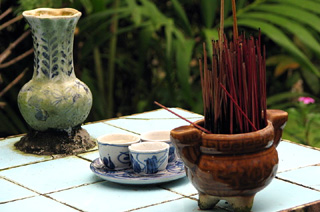“Tuu sang, tra trua” is a Vietnamese saying that translates as “Drink wine in the morning and tea at noon.” While some people may skip the wine, nobody in Vietnam will pass up the tea—morning, noon, or night.
All gatherings begin and end with tea. It’s placed on ancestral altars, used in toasts, and served to all guests. At festivals, weddings, funerals, and business meetings, small cups of bitter Vietnamese green tea are passed around.
Vietnamese Tea Etiquette
When a visitor arrives, the host—no matter how busy—will stop, wash his or her hands, rinse the tea set, and prepare the tea. This is a traditional act of deference and hospitality, and no important subjects should be broached without sharing a cup of tea first. While Vietnam lacks a formal tea ceremony like those in China and Japan, there are a number of rules for serving the perfect cup of tea.

According to tradition, Vietnamese tea should be made with rainwater or, better yet, dewdrops collected from lotus leaves at dawn. A standard tea set includes a teapot, four small cups, and a large cup to be used for straining or pouring. The best tea sets are the blue and white ones from Bat Trang village on the outskirts of Hanoi, or the antique, dark yellow porcelain ones from Giang Xi province in China.
When making tea, always use boiling water and fill the teapot to overflowing. A shallow saucer should be placed under the teapot to catch the overflow, thereby warming the bottom of the teapot. When presented with a cup of hot tea, sip it slowly to enjoy the flavour.

